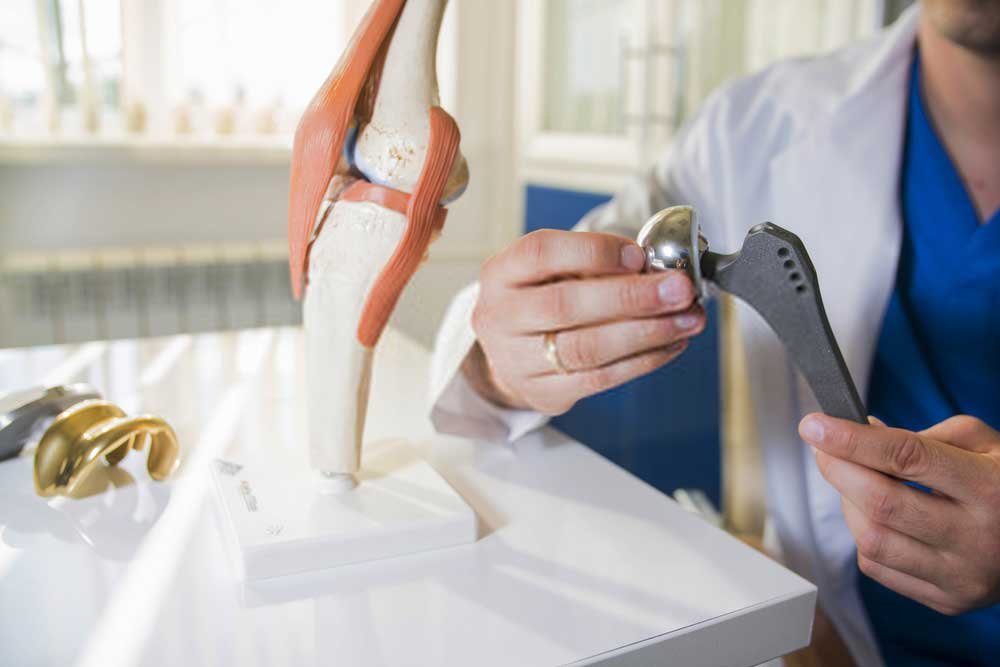Joint replacement is a type of surgery, in which components of joints are replaced with the artificial ones (prosthesis). Most often, patients see orthopedists with a pathology of the hip joint. German doctors have achieved great success in the field of orthopedics. Therefore, many foreign residents want to undergo hip replacement in Germany.
Anatomy of the hip
The hip is the biggest joint in the body. It is a ball and socket joint: the socket is represented by an acetabulum of the pelvic bone and the ball — by a femoral head. Articular surfaces of bones are covered with cartilage, which prevents the bones from rubbing each other.
Various diseases cause the destruction of joint elements. In this cases, doctor may suggest a hip replacement. The artificial joint totally imitates the structure of the hip joint. It consists of three parts: the acetabular cup, the femoral component, and the insert. The main parts of the endoprosthesis are made of metal, the insert — of polyurethane.
Indications for an operation
Hip replacement is indicated when the joint can no longer function normally. A person experiences joint pain, hip stiffness, and limitation of mobility. These symptoms occur due to various diseases.
Main indications for hip replacement are:
- Osteoarthritis. This disease occurs among old people. Osteoarthritis leads to the gradual destruction of the articular cartilage.
- Arthritis. This is an inflammatory joint disease that leads to the destruction of the cartilage.
- Avascular necrosis. When the joint does not receive enough blood femoral head is deformed and destroyed.
- Hip fracture. In older people with hip fracture pieces of broken bones do not grow back together, therefore people become immobilized. Hip replacement can be an effective solution in this case.
Is hip replacement suitable for me?
The orthopedic surgeon may advise hip replacement surgery after the precise diagnosis making if there are definite indications. The main candidates for the surgery are people with hip pain that limits daily activities and is not eliminated by conservative therapy.
There is no age limit to replace a hip joint. Most patients who undergo hip replacement are over 50 years old. Nevertheless, this operation can be performed both in young and old people.
Preparation for surgery
The doctor makes a decision about the possibility of hip replacement surgery after a full examination of the patient. The surgeon examines the patient’s overall health, studies his medical history, finds out what medications the patient is taking.
Then the doctor performs a physical examination to assess hip mobility. The patient must undergo an X-ray examination or MRI. These tests help to determine the extent of joint damage.
How is the operation performed?
Before surgery, the patient is anesthetized. It may be general or spinal anesthesia.
The operation lasts for a few hours. The procedure consists of several stages:
- The surgeon makes an incision on the hip, pushes muscles and tendons to the sides, exposes the joint.
- The damaged parts of bones and whole cartilage of the hip joint are removed.
- Doctor implants metal stem with the ball on its upper end into the femur. The metal stem may be fixed with cement or tightly embedded into the bone with technology «press fit».
- A surgeon implants a metal socket (acetabulum) into the pelvic bone, he can use screws or cement for this.
- A polyurethane insert is fixed between metal parts of an artificial joint.
- The surgeon sutures the wound and puts a drain in it.
Recovery after an operation
After the operation, a patient is moved to the intensive care unit. Medics will monitor the patient’s blood pressure, pulse, and pain syndrome. The patient will be moved to the usual hospital room in a few hours.
In this period of time, a patient needs certain medications. He will get painkillers and blood-thinning drugs. Also, the patient should wear compression stockings. It will help to prevent blood clots formation.
Soon a patient will be able to sit up in a bed. A rehabilitologist will offer a recovery program that includes special exercises. In a few days, the patient can get up from the bed with crutches, and in a week — walk along the hall.
A patient will leave the hospital in a week. It is important to continue exercises at home and follow other medical advice. Full recovery may take a few months. Joint replacement allows to eliminate hip pain and return to normal life.
How to undergo joint replacement in Germany?
Every year thousands of foreign citizens come to Germany for joint replacement. This operation can be performed on various joints: hip, knee, shoulder, and so on. German doctors use the most modern prostheses that will serve for more than 20 years.
Patients can get treatment in Germany with the help of the company Booking Health. This is the medical tourism service that organizes treatment abroad. Booking Health will select the best orthopedic clinic and arrange treatment as soon as possible.



